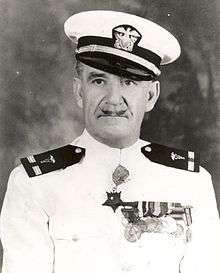Robert H. Stanley
Robert Henry Stanley (May 2, 1881 – July 15, 1942) was a 40-year member of the United States Navy. He was the first hospital corpsman to receive the nation's highest military decoration for valor, the Medal of Honor. He was awarded the medal for carrying messages under heavy fire on 13, 20, 21 and 22 June and 12 July 1900, while assigned to the USS Newark at Beijing (then Peking), China during the Boxer Rebellion.
Robert Henry Stanley | |
|---|---|
 Robert H. Stanley as a Chief Pharmacist | |
| Born | May 2, 1881 Brooklyn, New York |
| Died | July 15, 1942 (aged 61) Pensacola, Florida |
| Place of burial | |
| Allegiance | United States |
| Service/ | United States Navy |
| Years of service | 1898–1939 |
| Rank | Chief Pharmacist |
| Unit | USS Vermont USS Newark (C-1) USS America |
| Battles/wars | Spanish–American War Philippine–American War Boxer Rebellion World War I |
| Awards | Medal of Honor |
Early life and military career
Stanley was born Brooklyn, New York on 2 May 1881. On 28 March 1898, he enlisted in the Navy at age 16 aboard the receiving ship USS Vermont, moored at the Brooklyn Navy Yard. He served as a landsman and participated in the Spanish–American War, which was declared only a month after his enlistment, and the Philippine–American War which began in 1899.[1]
He was serving as a Hospital Apprentice on the USS Newark when the ship arrived in Tientsin, China on 22 May 1900.[2] The Newark had been sent during the China Relief Expedition to help relieve Allied forces fighting in the Boxer Rebellion. On 13 and 20, 21, and 22 June and 12 July, in Beijing (then known to Americans as "Peking"), he volunteered to carry messages between the American and British legations despite heavy fire,[1][3][4] "Chinese snipers were everywhere and Boxer militants fought viciously."[4]
For these actions, he was awarded the Medal of Honor a year later, on 19 July 1901.[3] The medal was presented to him aboard the armored cruiser USS Brooklyn.[1] Stanley, at age 19, was the youngest Medal of Honor recipient of the Boxer Rebellion.[5] He was also the first member of the U.S. Navy medical community to receive the award.[6]
Stanley was discharged from the Navy on 8 August 1901, which was one month after being awarded the Medal of Honor.
Stanley was a member of the Imperial Order of the Dragon, a fraternal society for veterans of the Boxer Rebellion of all ranks. This organization contrasted with the Military Order of the Dragon whose membership consisted solely of commissioned officers.
Later career
In 1917, Stanley re-enlisted in order to serve in World War I. During the war, he served on the USS America (ID-3006), a German passenger liner seized by the United States and converted to a troop transport.
Stanley was promoted to the warrant officer rank of Pharmacist on 5 August 5, 1920. He was promoted to Chief Pharmacist on 24 September 1923.
Retirement and death
Stanley retired from the Navy on 1 February 1939. He died in Pensacola, Florida, at age 61, on 15 July 1942. He was buried with his wife Mary Ellen (September 28, 1881 – September 15, 1930) at Arlington National Cemetery on 20 July 1942.[1] His grave can be found in section 7, lot 8348.[7]
Military awards
Stanley's military awards and decorations include:
- Medal of Honor
- Navy Good Conduct Medal
- Sampson Medal
- Spanish Campaign Medal
- Philippine Campaign Medal
- China Relief Expedition Medal
- Haitian Campaign Medal
- World War I Victory Medal with "TRANSPORT" clasp
Medal of Honor citation
His official citation reads:
Citation:
"In action with the relief expedition of the Allied Forces in China during the battles of 13, 20–22 June 1900. Throughout this period and in the presence of the enemy, Stanley distinguished himself by meritorious conduct."[8] "For distinguished conduct in the presence of the enemy in volunteering and carrying messages under fire at Peking, China, 12 July 1900."[3][9] "Hospital Apprentice Stanley's exceptional fortitude, inspiring initiative, and unrelenting devotion to duty reflect great credit upon himself and were in keeping with the highest traditions of the United States Naval Service."[4]
See also
References

- "Robert Henry Stanley". Pride of Place Hall of Honor Exhibit. National Naval Medical Center. Retrieved October 5, 2009.
- USS Newark (1890)
- "Medal of Honor recipients - China Relief Expedition". Medal of Honor citations. United States Army Center of Military History. August 3, 2009. Retrieved October 5, 2009.
- Health.mil - Military Health System & Defense Health Agency, Hospital Apprentice Robert Stanley
- Owens, Ron (2004). Medal of Honor: Historical Facts and Figures. Paducah, Kentucky: Turner Publishing Company. p. 75. ISBN 1-56311-995-1.
- "Medal of Honor". Navy Medicine. United States Navy. Retrieved 13 December 2018.
Robert Henry Stanley has the distinction of being the first hospital corpsmen, and Navy medical man, ever to receive the Medal of Honor.
- "Robert H. Stanley". Claim to Fame: Medal of Honor recipients. Find a Grave. Retrieved December 18, 2009.
- A History Showcase of the U.S. Navy medical Department, Hospital Apprentice Robert Stanley October 7, 2011.
- United States. Bureau of Naval Personnel (1910). Medal of Honor. p. 107.
External links
- "Arlington National Cemetery website". Robert Henry Stanley: Hospital Apprentice, United States Navy. Arlington National Cemetery website. November 6, 2005. Retrieved January 15, 2010.